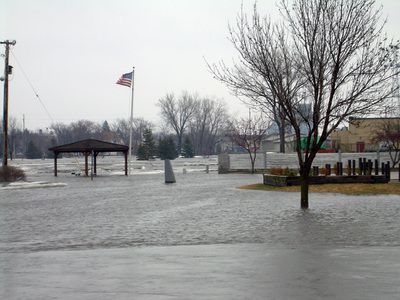If you’ve ever traveled US Highway 1 from Miami to Key West, you know what it’s like to drive around West Central Minnesota and eastern North Dakota tonight. Other than the water lapping the road edge on both sides, and the anticipation of a cold drink at your destination, there the similarity ends.
The flood is a disaster still waiting to happen in Fargo and Moorhead, but it arrived on Monday in Breckenridge, a town that was heavily damaged in the great flood of ’97, but often loses out to its bigger neighbors to the north when it comes to attention.
Late Monday afternoon, the fire department and other volunteers on the Breckenridge side started putting up a flood wall they purchased after the ’97 flood. It took awhile to figure out where Part A connects to Part B, and the Red River wasn’t waiting. It had already inundated the town park. Within a half hour, however, the wall was up, protecting the western flank from the rising river, and bulldozers began building a dike across the Minnesota Ave. bridge, cutting the city off. Wahpeton, North Dakota was soon to be on its own.
“I’ve never lived through a flood before,” Breckenridge resident Carri Johnson told me as she helped assemble the flood wall. She said Monday was the first day she’s been nervous. “I’ve never lived anywhere where a flood was even a threat, so I’ve just been watching people’s faces because they lived through the 1997 flood and then day by day you can see the fear and… so I’m really watching my husband’s face and when he gets scared, that’s when I’m going to get scared.”
Her husband, a firefighter, was in Breckenridge for the ’97 flood.
“I saw a little nervousness today,” she said.
She says she has volunteers ready to help her sandbag around her home if the water goes higher. ()

It will go higher, says Captain Chuck Moore of the Minnesota National Guard (above right). He’s in charge of about 40 Guardsmen, who were sent down to Breckenridge at the city’s request after they were initially deployed to Moorhead.
In a makeshift office on the second floor of the Breckenridge City Hall, within spitting distance of the river, Moore coordinates six teams who have been deployed around the city. They’re keeping an eye on a sandbagging location south of town because he’s heard some communities have tried to steal sandbags from other communities.
“Sometime tomorrow (Tuesday) is the crest… they’re expecting it to crest for two or three days,” he said. ()
It’s not just the Red River that’s causing the problem. In Breckenridge, the Otter Tail River has also spilled over, leaving mud down one city street. Across the Red River, the Sheyenne River is cutting off access to the bright lights of what passes for the big cities here.
The curse of March is that four or five months from now, if history holds, there’ll be a shortage of water here and whatever crops can be planted this year will be parched. But for now, it’s Water World in this section of the Upper Midwest.
Not long after I talked to both Johnson and Moore, I found myself cut off from Moorhead, my final destination for the day. I’d already been told that Highway 75 was closed, so I headed to North Dakota for Interstate 29, but it was closed, too. I drove another 25 miles, and found every road north blocked.
I turned around and headed back to Breckenridge, but by then the bridge into downtown had been sealed. I tried several back streets and found Highway 210 open enough to get into town. By the time darkness fell, so had heavy rain, which flooded most of the roadways north to Moorhead.
I shared the road only with the occasional dump truck, carrying sand to the river.

